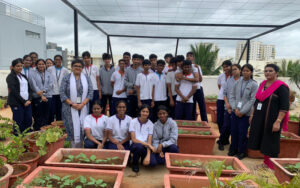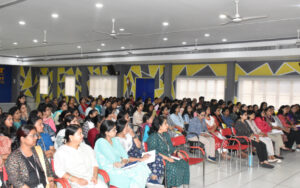Did you know that there are 9 types of poetry?
Poetry can seem intimidating because there are so many different styles and formats. In fact, they are all open to interpretation and have various meanings. They can seem dry on the surface and there is no exact way to learn, interpret or understand them like other subjects. But that is what makes poetry so special. You understand it the way you want to understand it. You relate to it based on what you are going through.
ICSE schools in Bangalore have put a lot of effort to introduce students to the masters of poetry that have given us some of the most famous poetry that we read today – Robert Frost, Shakespeare, John Keats, Maya Angelou, Sarojini Naidu to Emily Dickinson! They have left behind pieces that can transform lives and bring peace to individuals in their own special way. However, as a student that enjoys poetry you must first understand the different types of poetry. Of course, today we see many contemporary styles of poetry that do not conform to these rules; which makes it beautiful in its own way. But what you read in your books is still somewhat relevant to the 9 types of poetry that we will discuss in the rest of this blog so read on!
Haiku:
- Known as Haiku or Hokku
- Ancient form of Japanese poetry that is now famous around the world
- Contains 3 lines – tercet
- The first line has 5 syllables, the second has 7 syllables and the third has 5 syllables again
- Haiku words do not have to rhyme
Dwells on a mood or situation like haiku poems about life or haiku poems about nature
So, is a haiku only 3 lines? Traditionally, yes! Here’s a haiku example of a famous Haiku by Kobayashi Issa
“A World of Dew” by Kobayashi Issa
A world of dew,
And within every dewdrop
A world of struggle.
Free Verse:
- Modern poetry
- Does not conform to traditional structures of poetry
- May or may not rhyme
- Can have as many lines or stanzas as the poet wishes to include
Free verse poem is a more contemporary style of writing poetry and here is a free verse example that was written many years ago (1952) and became quite the talk of town with its unconventional manners because it lacks punctuation and some say that the void actually adds to its fluidity:
E.E. Cummings’s “[i carry your heart with me(i carry it in]”
i carry your heart with me(i carry it in
my heart)i am never without it(anywhere
i go you go,my dear;and whatever is done
by only me is your doing,my darling)
i fear
no fate(for you are my fate,my sweet)i want
no world(for beautiful you are my world,my true)
and it’s you are whatever a moon has always meant
and whatever a sun will always sing is you
Acrostic
- Usually spells out a name or word, phrase or message
- To do so it uses the first letter of each line of the poem
- It may or may not rhyme
- The word that is spelt out plays on the theme of the poem
Here are some acrostic poem examples:
A simpler example for acrostic poetry would be Hope in a Dream by Adalia Medina:
Hold onto your dream while mindful of time.
Optimism required, let your light shine.
Persistence prevails, while some may cast doubt.
Expectation desired is what it’s about.
On a relatively complex note:
An Acrostic – Edgar Allen Poe
Elizabeth it is in vain you say
“Love not” — thou sayest it in so sweet a way:
In vain those words from thee or L.E.L.
Zantippe’s talents had enforced so well:
Ah! if that language from thy heart arise,
Breath it less gently forth — and veil thine eyes.
Endymion, recollect, when Luna tried
To cure his love — was cured of all beside —
His follie — pride — and passion — for he died.
Sonnets
- Sonnet poems are an old form of poetry
- Made famous by William Shakespeare
- Originated in 13th century Italy through poet Petrarch
- Derived from the Italian word ‘sonnetto’ meaning a ‘little song’
- Sonnets contain 14 lines and usually revolve around love
- Petrarchan sonnets/Italian sonnets follow the ABBA ABBA CDE CDE rhyme scheme
- Shakespearean sonnets/English sonnets are usually ABAB CDCD EFEF GG
Now that you know what a sonnet poem is and here is your sonnet example for the day:
Sonnet 116 by William Shakespeare
Let me not to the marriage of true minds
Admit impediments. Love is not love
Which alters when it alteration finds,
Or bends with the remover to remove.
O no! it is an ever-fixed mark
That looks on tempests and is never shaken;
It is the star to every wand’ring bark,
Whose worth’s unknown, although his height be taken.
Love’s not Time’s fool, though rosy lips and cheeks
Within his bending sickle’s compass come;
Love alters not with his brief hours and weeks,
But bears it out even to the edge of doom.
If this be error and upon me prov’d,
I never writ, nor no man ever lov’d.
Villanelle
- Villanelle poetry is another old form of poetry
- Originated in France and has many rules
- Made up of 19 lines
- Five stanzas of three lines (tercet)
- Final stanza of four lines (quatrain)
- Villanelle poetry rhyme scheme is usually ABA ABA ABA ABA ABA ABAA
- This type of poetry only has two rhyming sounds
- Villanelle poetry contains a lot of repetition throughout
- Line one is repeated in lines 6, 12 and 18
- Line three is repeated in lines nine, 15 and 19
Now that you know what villanelle poetry rules are and how villanelle poetry is written here is a famous villanelle poetry example:
A Dainty Thing’s The Villanelle – William Ernest Henley
A DAINTY thing’s the Villanelle,
Sly, musical, a jewel in rhyme,
It serves its purpose passing well.
A double-clappered silver bell
That must be made to clink in chime,
A dainty thing’s the Villanelle;
And if you wish to flute a spell,
Or ask a meeting ‘neath the lime,
It serves its purpose passing well.
You must not ask of it the swell
Of organs grandiose and sublime–
A dainty thing’s the Villanelle;
And, filled with sweetness, as a shell
Is filled with sound, and launched in time,
It serves its purpose passing well.
Still fair to see and good to smell
As in the quaintness of its prime,
A dainty thing’s the Villanelle,
It serves its purpose passing well.
Limerick
- Meant to be funny or rude
- Made popular by Edward Lear in the 19th century
- AABBA is the set rhyme scheme for limerick poetry
- Lines one, two and five are longer in length than lines three and four
- The last line of limerick poetry is usually the punchline
Limerick poetry is usually light and funny here’s an example:
God’s plan made a hopeful beginning.
But man spoiled his chances by sinning.
We trust that the story
Will end in God’s glory,
But at present the other side’s winning.
Ode
- It is known to be one of the oldest forms of poetry
- May have originated from ancient Greece
- The word ode has been derived from the Greek word ‘aeidein’ meaning ‘to sing or chant’
- Originally performed with a musical instrument
- Usually written to praise a person, event or thing
We hope this blog helped you understand what is an ode in simple terms. Here is an ode example:
Ode to the West Wind Percy Bysshe Shelly
O wild West Wind, thou breath of Autumn’s being,
Thou, from whose unseen presence the leaves dead
Are driven, like ghosts from an enchanter fleeing,
Yellow, and black, and pale, and hectic red,
Pestilence-stricken multitudes: O thou,
Who chariotest to their dark wintry bed
The winged seeds, where they lie cold and low,
Each like a corpse within its grave, until
Thine azure sister of the Spring shall blow
Her clarion o’er the dreaming earth, and fill
(Driving sweet buds like flocks to feed in air)
With living hues and odours plain and hill:
Wild Spirit, which art moving everywhere;
Destroyer and preserver; hear, oh hear!
Elegy
- Does not have a rule per say
- Usually based around the subject of death
- Usually about a loved one that has passed away
- Some have a sad yet hopeful ending
Elements of elegy may seem intimidating but we hope this blog helped you understand what is an elegy, so here is an elegy example:
‘On My First Sonne’ was written excellently by Ben Jonson and published in 1616 after the death of his 7 year old son – Benjamin in the year 1603.
Farewell, thou child of my right hand, and joy;
My sin was too much hope of thee, lov’d boy.
Seven years tho’ wert lent to me, and I thee pay,
Exacted by thy fate, on the just day.
O, could I lose all father now! For why
Will man lament the state he should envy?
To have so soon ‘scap’d world’s and flesh’s rage,
And if no other misery, yet age?
Rest in soft peace, and, ask’d, say, “Here doth lie
Ben Jonson his best piece of poetry.”
For whose sake henceforth all his vows be such,
As what he loves may never like too much.
Ballad
- Old and traditional form of poetry
- Revolves around a dramatic or emotional story
- Originated from Europe in the late Middle Ages
- Often heard with music
- Usually they have four lines (quatrain) and have a set rhyme scheme of ABAB or ABCB
Ballad poems may seem difficult to understand, so here’s a Ballad example of an ancient piece that first appeared in print in 1802, in Walter Scott’s Minstrelsy of the Scottish Border. It was also collected by Francis James Child. This ballad became particularly popular in America and has many variants.
The Wife of Usher’s Well
‘I wish the wind may never cease,
Nor fashes in the flood,
Till my three sons come hame to me,
In earthly flesh and blood.’
It fell about the Martinmas,
When nights are lang and mirk.
The carline wife’s three sons came hame,
And their hats were o’ the birk.
It neither grew in syke nor ditch,
Nor yet in ony sheugh;
But at the gates o’ Paradise,
That birk grew fair eneugh.
‘Blow up the fire, my maidens,
Bring water from the well;
For a’ my house shall feast this night,
Since my three sons are well.’
And she has made to them a bed,
She’s made it large and wide;
And she’s ta’en her mantle her about,
Sat down at the bed-side.
Up then crew the red, red cock,
And up and crew the gray
The eldest to the youngest said,
‘Tis time we were away.’
The cock he hadna craw’d but once,
And clapp’d his wings at a’,
When the youngest to the eldest said,
‘Brother, we must awa’.
‘The cock doth craw, the day doth daw,
The channerin’ worm doth chide;
Gin we be miss’d out o’ our place,
A sair pain we maun bide.’
‘Lie still, lie still but a little wee while,
Lie still but if we may;
Gin my mother should miss us when she wakes,
She’ll go mad ere it be day.’
‘Fare ye weel, my mother dear!
Fareweel to barn and byre!
And fare ye weel, the bonny lass
That kindles my mother’s fire!’
This blog should work as an amazing learning curve and also handy notes given to you by your school! Make use of it, learn from it and fall in love with the versatility of this art form – poetry!
New Horizon Public School (NHPS) – the best ICSE school in Bangalore for students to pick up on knowledge, art, dance, music and any extracurricular of a student’s choice is the perfect place for ICSE admissions. The best schools in Bangalore and top 10 ICSE schools in Bangalore like NHPS provide stellar opportunities for students to fully explore their potential in the world today. New Horizon Public School, Bangalore is known to be the best ICSE school in Bangalore and one among the list of best ICSE schools in Bangalore because of its approach towards education and ability to churn out smart, sensitive and responsible young adults.
So, what are you waiting for, click the link to the ICSE admission form to the best ICSE school in Bangalore!



